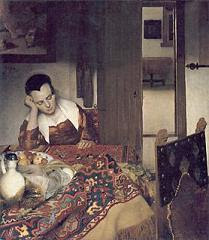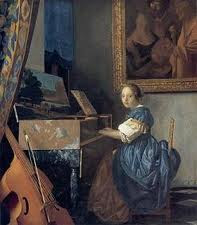 Berlinn, Gemäldegalerie SMPK / / www.smb.spk-berlin.deThe Wine Glass (also known as The Glass of Wine or Lady and Gentleman Drinking Wine) portrays a seated woman and a standing man drinking in an interior setting. It contains figures situated in a brightly lit and spacious interior, while its architectural space is highly defined. In addition, the work's figures are set in the middle ground, rather than positioned in the foreground.
Berlinn, Gemäldegalerie SMPK / / www.smb.spk-berlin.deThe Wine Glass (also known as The Glass of Wine or Lady and Gentleman Drinking Wine) portrays a seated woman and a standing man drinking in an interior setting. It contains figures situated in a brightly lit and spacious interior, while its architectural space is highly defined. In addition, the work's figures are set in the middle ground, rather than positioned in the foreground.The work is, in many aspects, typical of the genre painting of the Delft School developed by Pieter de Hooch in the late 1650s. The concept of figures drinking around a table, and the portrayal of a woman drinking from a glass are taken directly from De Hooch's A Dutch Courtyard. However, Vermeer's work breaks away from the prototypes of De Hooch in that the interior is rendered in a far more elegant and higher-class setting than the older master's works.
Compared to his earlier paintings, Johannes Vermeer's brushwork in The Wine Glass is subdued, while the faces and clothes of the figures are depicted with wide smooth outlines. Only in the tapestry of the tablecloth and the window glass did the artist apply finely detailed, linear brush strokes.
Source:
en.wikipedia.org
More information paintings Vermeer
About Vermeers work






